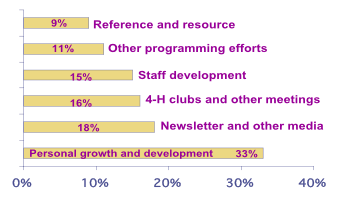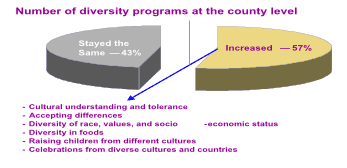February 2002 // Volume 40 // Number 1 // Ideas at Work // 1IAW2
Evaluating a Diversity Educational Resource in Cooperative Extension
Abstract
A variety of efforts are under way to help build the capacity of Cooperative Extension to effectively serve culturally diverse communities. In Pennsylvania, one such effort was the development of Diverse Issues, a quarterly newsletter. The newsletter is mailed to Extension professionals across the state. This article describes this "idea at work" and the feedback received from those who read it. Extension professionals generally consider Diverse Issues as a valued diversity educational resource.
Introduction
The cultural landscape of American society has been changing dramatically in the last 25 years and will continue to change. By mid-century no racial/ethnic group in the U.S. will be in the majority. The African American, Hispanic/Latino, and Asian American populations in this country are increasing at rates faster than the Caucasian population (Population Reference Bureau, 2001).
The changes in the diversity of our society extend beyond race and culture. The elderly will continue to comprise a larger segment of our population: people 85 years and older are the fastest growing age group in the nation (Brock, 2001). Single-parent families, blended families, and other alternative family structures are becoming commonplace; about 50% of all children born in the U.S. will spend at least part of their childhood with only one parent (Lamb, 1999). Gay, lesbian, bisexual, and transgender people are choosing to be open in their communities and work places. People with physical and mental disabilities are more actively seeking to be contributing members of society. The fastest growing religion in this country is Islam (Arnett, 1998). And an increasing number of people are speaking languages other than English in public settings.
The result is clear: our social institutions, including the Cooperative Extension System, will need to change in order to effectively serve the diversity of communities and families across this nation. The mission of Cooperative Extension is to provide university-based educational services to communities, organizations and families.
Description of Newsletter
In states across the country, a variety of efforts, large and small, are underway to help build the capacity of Cooperative Extension to more effectively serve our culturally diverse communities. In Pennsylvania, one such effort was the development of Diverse Issues, a quarterly newsletter distributed to Extension professionals across the state. The goal of the newsletter is to increase an awareness of, appreciation for, and valuing of diversity. Each issue includes five "regular topics." They are described as follows.
- Diversity in People has covered such topics as: the Amish, Arabs,
bi-racial people, alternative family structures, gays, the obese, characteristics
of rural/urban/and suburban communities, and child rearing practices of diverse
populations.
- Diversity in the Workplace focuses on issues related to working with
people who are different from oneself.
- Diversity Activity shares an activity that professionals can
use with youth and/or adult groups to help increase awareness of diversity.
- Diversity Resource provides descriptions and sources for educational
materials specifically prepared for diverse audiences, clip art depicting
diverse populations, and diversity-related web sites.
- Diversity Around the State is an opportunity to showcase the diversity activities and efforts of Extension professionals in the counties.
The newsletter is available in both hard copy and on the Internet. Issues may be downloaded and printed from the Web site http://AgExtEd.cas.psu.edu/FCS/pi/newsletters.html. Ten editions of Diverse Issues were published between September, 1998 and October 2000. In an effort to evaluate the usefulness and future direction of this newsletter as an educational resource, feedback was requested from the readers.
Use of Diverse Issues Newsletter
We wanted to know how Diverse Issues has been used by Extension professionals (Figure 1). One hundred and thirty-six (136) responses to this question were received. The most frequent response was that Diverse Issues was used as a source for personal growth and development (33%). Other uses of the newsletter were:
- Inclusion of articles in county newsletters and other media (18%);
- Use of the activities with 4-H clubs, groups, and other Extension meetings (16%);
- Staff development for Extension professionals and volunteers (15%);
- Use in various Extension programming efforts in the community (11%); and
- Use as a reference and resource (9%).
Figure 1.
Use of Diverse Issues

In addition to sharing the newsletter with Extension staff and 4-H youth and leaders, respondents indicated that the newsletter is shared with Extension advisory boards and committees, Expanded Foods and Nutrition Education Advisors, human service agencies and organizations, various community coalitions, schools, and church groups.
An attempt was also made to study how the newsletter has influenced diversity programs at the county level (Figure 2). The majority (57%) of respondents indicated that the number of county programs related to diversity issues had increased over the past 4-5 years. For 43% of the respondents, however, the level of diversity programming had remained the same. Some of the specific topics mentioned for diversity programming at the county level included:
- Cultural understanding and tolerance;
- Accepting differences;
- Diversity of race, values, and socioeconomic status;
- Diversity in foods;
- Raising children from different cultures;
- Relating to others with physical challenges;
- Holiday celebrations from diverse cultures and countries;
- Acceptance of gays in the workplace;
- How we are all alike;
- Similarities among various cultural customs; and
- Requirements of the Americans With Disabilities Act.
Figure 2.
Impact of Diverse Issues

Respondents were asked a series of questions designed to reflect the impact of Diverse Issues on Extension professionals and their programming (Figure 3). Responses suggest that with Diverse Issues Extension professions are more likely than without Diverse Issues to:
- Use diversity information in their programming;
- Have a greater level of comfort dealing with diversity issues; and
- Have an increased level of knowledge, awareness, and understanding of diversity issues.
A much smaller percentage, however, reported having increased requests to do diversity programming.
Figure 3.
Impact of Diverse Issues

Outcome/Impact
The study sought to determine the usefulness and impact of a diversity-focused newsletter as an educational resource for Extension professionals. Based on the findings of this study, the following conclusions are drawn.
- Extension professionals consider Diverse Issues as a valued diversity educational resource. They also agree that the content, topics, and frequency of publication and format are appropriate.
- Extension professionals have shared Diverse Issues with other groups in the communities. A majority of professionals indicated that the number of programs they conduct relative to diversity has increased. The availability of a "ready-made" resource may have been instrumental in increasing the likelihood that Extension professionals would incorporate diversity education into programming with community organizations and clientele.
- Diverse Issues newsletter has increased the knowledge, awareness, and understanding of diversity-related issues. Extension professionals indicate a greater comfort level in dealing with diversity issues.
The positive feedback from the users of Diverse Issues newsletter suggests the need for up-to-date information on diversity-related issues. This is indeed a significant outcome if one looks at the recent Census data and projections for the future.
References
Arnett, E. C. (1998, January 2). Muslims entering mainstream America. Centre Daily Times, 2, pp. A6.
Brock, J. N. (2001). The evolution of the aging population. The Aging of America Series. Retrieved April 18, 2001 from the World Wide Web: http://www.cba.gsu.edu/magazine/aging.html
Lamb, M. E. (1999). Parental behavior, family processes and child development in nontraditional and traditionally understudies families. In M. E. Lamb (Ed.), Parenting and child development in nontraditional families. New Jersey: Lawrence Erlbaum Associates.
Population Reference Bureau and Social Science Data Analysis Network (2001). The changing American pie, 1999 and 2025. Retrieved April 2, 2001 from the World Wide Web: http://www.ameristat.org/
Strategic Planning Task Force on Diversity. (1991). Pathways to diversity: Strategic plan for the Cooperative Extension System's emphasis on diversity. [Working Document] USDA.
